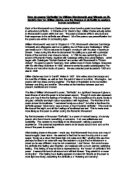In terms of structure the poems differ. William Wordsworth’s is very tightly structured. It has four distinct stanzas with a highly regular rhyme scheme. In each, the first line rhymes with the third the second with the fourth and the fifth with the sixth. Each line comprises eight syllables with six lines each. Clarke’s poem, on the other hand, contains seven five-line stanzas with lines of varying length no deliberate rhyme-scheme, the use of enjambment and one final section comprising three lines.
The context of the first poem emphasises the poets use of a powerful imagination “ fluttering and dancing in the breeze,” to create a series of mental pictures. The satisfaction he gains from recreating the images in his mind fills “his hear with pleasure” Clarke’s experience is also heart warming in that it involves many people. And is less about the poet herself than in her interest in the transforming power of poetry for another.
In “The Daffodils” William Wordsworth’s method is to recount an imaginary walk in which he floats above the country side metaphorically revealing the lightness of his mood he describes the location and the density of the daffodils and personifies them by saying the “tossing their heads in springy dance” and their beauty not only affects his beauty and heart but also the rest of nature around them “the waves beside them danced” he comments of he ability these daffodils have to raise human spirits and it is clear from the last two lines of the stanza three that at the time he was completely unaware of the massive impact the sight had on him and how he would in the future revisit this imaginary scene and take from it such strength and such happiness.
Clarke’s poem demonstrates a different method and development. Once again a poet is reflecting upon an experience but this time the context is a poetry reading and the grey area between sanity and insanity where they become the battleground in which poetry must be heard. Clarke, like William Wordsworth, compares nature including trees and daffodils to human beings. There are a number of images of mentally crippled individuals “A schizophrenic on a good day” a fair haired boy is described. Tension is created when the powerful, dumb, labouring man is “suddenly, standing silently huge and mild, but I feel afraid.”
Fear turns to delight towards the end of the poem as the sick man shows signs of becoming whole again because he has been cured by the poetry he hears into speaking for the first time in several decades. Throughout the poem there has been a sense of the daffodils supervising this recovery. As suddenly the power of the suns heat turns the daffodils “to flame.”
In terms of tone there is a variation between the two poems. William Wordsworth’s is constantly happy and uplifting while Clarke’s is at first cautious changing into a mood of wonder before the poem closes.
William Wordsworth’s mood is one of delight; Clarke’s is one of unease and finally one of increasing awareness. Atmosphere differs in the way that the first poem quick with a sense of heaven like beauty that it is hard to leave “I gazed and gazed.” Whereas Clarke’s poem depends for affect on the tension between images of imprisonment and restriction and those of freedom like in the fifth stanza.
In both poems the natural images come to the top. There is much sparkle, colour, and warmth while these are constant in William Wordsworth poem there is a contrast in Clarke’s poem with images of “the insane”. Both poems move at moderate pace “The Daffodils” shows a regular pattern and constant rhythm while the movement of “Miracle On St David’s Day” is irregular and very much dependent on the story of the poem. Language is made to fit context well but William Wordsworth’s language is typical of the early nineteenth centaury and Clarke’s clearly belongs to the twentieth in both cases vocabulary and structure are relatively simple with both benefiting from frequent use of devices such as metaphors alliteration and hyperbole.







